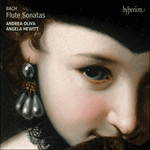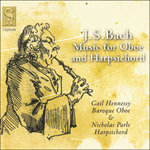The Sonata in C major for flute and continuo, BWV1033, is preserved in a manuscript in the hand of C P E Bach, dating from the early 1730s, and in which he attributes the piece to his father. Its origins are obscure and disparate, perhaps since its first two movements, at least, are arguably more convincing as pieces for an unaccompanied melody instrument. Yet, in spite of sequential and cadential crudities, the music is not without either merit or charm and is, by and large, satisfying to play. There is a shapely nobility to the opening ‘Andante’, and a far from displeasing virtuosity, however simply conceived, in the ensuing ‘Allegro’. The music of greatest substance, though, is to be found in the ‘Adagio’ which, like the concluding Minuets, ‘alternativement’, is not devoid of Bachian character. Bach’s hand can surely be sensed, too, in the fully written-out parts of the first Minuet which bears relationship to a movement of a concerto by Bach’s Merseburg contemporary, Christoph Förster; but, be that as it may, the sonata is uneven in quality and inconsistent in technique. It has been suggested that the harpsichord accompaniment was added later, perhaps by one of Bach’s pupils.
from notes by Nicholas Anderson © 2002
La Sonate en do majeur pour flûte et continuo, BWV1033, est préservée dans un manuscrit de la main de C. P. E. Bach datant du début des années 1730, dans lequel il attribue cette pièce à son père. Ses origines sont obscures et disparates, peut-être, car les deux premiers mouvements, pour le moins, seraient sans doute plus convaincants en tant que pièces pour instrument mélodique non accompagné. Pourtant, en dépit d’enchaînements et de cadences un peu abrupts, la musique ne manque ni de mérite ni de charme et est agréable à jouer dans l’ensemble. L’«Andante» initial est d’une élégante noblesse, et la virtuosité de l’«Allegro» suivant, quoique simplement conçue, est loin d’être déplaisante. La musique la plus substantielle se trouve cependant dans l’«Adagio» qui, comme les deux «Menuets» conclusifs, donnés «alternativement», n’est pas sans évoquer Bach. La main du maître se fait certainement sentir en outre dans les parties, intégralement notées, du premier «Menuet», qui présente une parenté avec un mouvement d’un concerto de Christoph Förster, compositeur de Merseburg contemporain de Bach; quoi qu’il en soit, cette sonate est d’une qualité inégale et d’un degré de technicité variable. Il a été suggéré que l’accompagnement de clavecin avait pu être ajouté tardivement, peut-être par un élève de Bach.
extrait des notes rédigées par Nicholas Anderson © 2002
Français: Josée Bégaud
Die Sonate in C-Dur für Flöte und Basso continuo, BWV1033, blieb in einem Manuskript in der Handschrift von C. Ph. E. Bach erhalten, das vom Beginn der 1730er Jahre stammt, und in welchem er das Stück seinem Vater zuschreibt. Die Ursprünge der Sonate sind obskur und disparat—vielleicht, weil zumindest ihre letzten beiden Sätze wahrscheinlich überzeugender als Stücke für Solo-Melodieinstrument wirken würden. Und doch mangelt es der Musik trotz sequenzieller und kadenzieller Ungeschliffenheiten nicht an Vorzügen oder Reiz, und im großen Ganzen ist ihr Vortrag für den Musiker befriedigend. Das eröffnende „Andante“ ist von wohlgestalteter Vornehmheit, und das folgende „Allegro“ weist eine höchst angenehme, wenn auch ziemlich schlicht konzipierte Virtuosität auf. Die Musik des „Adagio“ besitzt jedoch die reichste Substanz, und wie den abschließenden, „alternativement“ zu spielenden „Menuets“ mangelt es auch ihr nicht an Bachschem Charakter. Bachs Hand ist gewiss auch in den voll ausgeschriebenen Instrumentalstimmen des ersten Menuets zu spüren, das eine Verwandtschaft zu einem Konzertsatz von Bachs Merseburger Zeitgenossen Christoph Förster aufweist; aber—wie dem auch sei—die Qualität der Sonate ist uneben und ihre Technik uneinheitlich. Man vermutete, dass die Cembalobegleitung später vielleicht durch einen Schüler Bachs hinzugefügt wurde.
aus dem Begleittext von Nicholas Anderson © 2002
Deutsch: Atlas Translations


 Bach: Flute Sonatas
Bach: Flute Sonatas Bach: Music for oboe and harpsichord
Bach: Music for oboe and harpsichord
